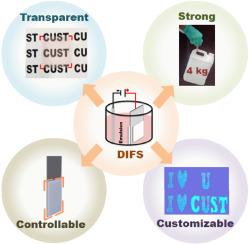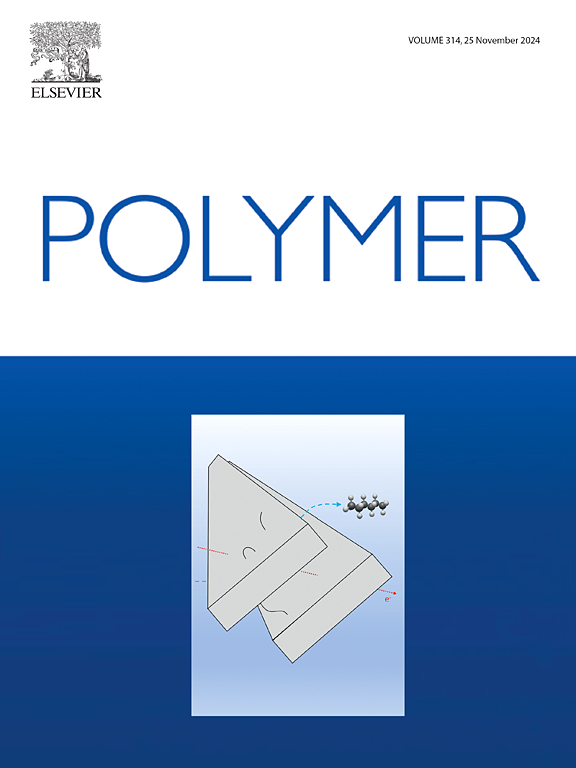快速制造受头足类启发的荧光团集成水性聚氨酯薄膜,用于可定制的图案和加密
IF 4.1
2区 化学
Q2 POLYMER SCIENCE
引用次数: 0
摘要
使用单荧光材料的传统加密技术越来越容易受到攻击,因为它们对刺激的反应是可预测的。此外,传统的水性聚氨酯(WPU)薄膜制造方法,如铸造,干燥时间长,厚度不一致,限制了先进应用的可扩展性。为了解决这些问题,我们开发了受头足类动物启发的WPU复合薄膜,该薄膜将6,7-二羟基香豆素(6,7- cu)和苝四羧酸(PTCA)作为分离层中的荧光团。该胶体体系具有良好的乳液稳定性和界面相互作用,对膜的复杂功能起着至关重要的作用。染料的羟基和羧基增强了WPU的光学性能和机械强度,在100 μm薄膜中拉伸强度达到24 MPa。利用电化学破乳诱导快速凝固(DIFS)方法,克服了传统铸造的局限性,实现了快速干燥和均匀成膜。这种方法利用受控的界面动力学来生产具有复杂的多色响应和改进的加密复杂性的薄膜。密度泛函理论(DFT)计算进一步揭示了薄膜的刺激响应性,为界面机制对紫外光和pH变化下其可逆颜色转换的影响提供了见解。在数据雕刻和QR码标签上的应用表明了这种薄膜在安全信息加密和防伪技术方面的潜力。本文章由计算机程序翻译,如有差异,请以英文原文为准。

Rapid fabrication of cephalopod-inspired fluorophore-integrated waterborne polyurethane films for customizable patterns and cryptographic encryption
Traditional encryption technologies using single-fluorescent materials are increasingly vulnerable to attacks due to their predictable responses to stimuli. Furthermore, conventional waterborne polyurethane (WPU) film fabrication methods, such as casting, suffer from long drying times and inconsistent thickness, limiting scalability for advanced applications. To address these issues, we developed cephalopod-inspired WPU composite films that integrate 6,7-dihydroxy coumarin (6,7-CU) and perylene tetracarboxylic acid (PTCA) as fluorophores in segregated layers. This colloidal system achieves good emulsion stability and interfacial interactions, which play a crucial role in the films' complex functionality. The dyes’ hydroxy and carboxylic acid groups strengthen both optical properties and mechanical strength of WPU, achieving a tensile strength of 24 MPa in a 100 μm thin film. Using the electrochemical demulsification-induced fast solidification (DIFS) method, we achieved rapid drying and uniform film formation, overcoming the limitations of traditional casting. This method leverages controlled interfacial dynamics to produce films with sophisticated multicolor responses and improved encryption complexity. Density functional theory (DFT) calculations further reveal the films' stimuli-responsiveness, providing insights into the influence of interfacial mechanisms on their reversible color transformations under UV light and pH changes. Applications in data engraving and QR code labeling demonstrate the films' potential in secure information encryption and anti-counterfeiting technologies.
求助全文
通过发布文献求助,成功后即可免费获取论文全文。
去求助
来源期刊

Polymer
化学-高分子科学
CiteScore
7.90
自引率
8.70%
发文量
959
审稿时长
32 days
期刊介绍:
Polymer is an interdisciplinary journal dedicated to publishing innovative and significant advances in Polymer Physics, Chemistry and Technology. We welcome submissions on polymer hybrids, nanocomposites, characterisation and self-assembly. Polymer also publishes work on the technological application of polymers in energy and optoelectronics.
The main scope is covered but not limited to the following core areas:
Polymer Materials
Nanocomposites and hybrid nanomaterials
Polymer blends, films, fibres, networks and porous materials
Physical Characterization
Characterisation, modelling and simulation* of molecular and materials properties in bulk, solution, and thin films
Polymer Engineering
Advanced multiscale processing methods
Polymer Synthesis, Modification and Self-assembly
Including designer polymer architectures, mechanisms and kinetics, and supramolecular polymerization
Technological Applications
Polymers for energy generation and storage
Polymer membranes for separation technology
Polymers for opto- and microelectronics.
 求助内容:
求助内容: 应助结果提醒方式:
应助结果提醒方式:


